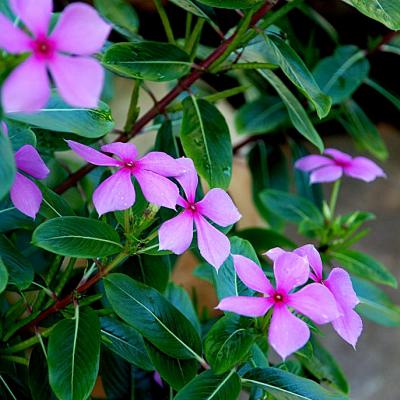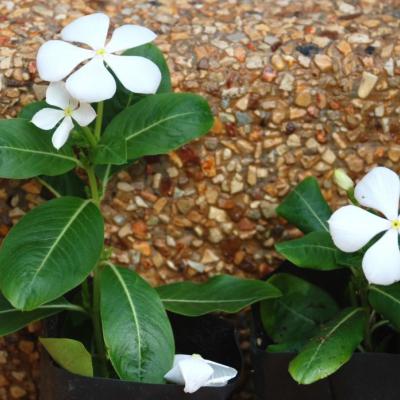Apocynaceae-Catharanthus-roseus
Classification
- Botanical Family : Apocynaceae
- Genus : Catharanthus
- Epithet : roseus
- German Family Name: Hundsgiftgewächse
- English Name: Madagascar Periwinkel
- Thai Name: แพงพวย
- Thai Phonetic: paeng puai
- Author: (L.) G.Don
- Height: 0.80
Water Requirements
Plant Type
Light Requirements
Cultivation
The five petals fused into a tube vary in color from white to pink to purple. The flowers of the natural wild plants are pale pink with a purple "eye" at its core. When the flowers white and violet are cultivated varieties. Catharanthus roseus blooms the year round.
It has glossy, dark green, oval leaves.
To keep the plant bushy growth, it can be cutted on a regular basis. At the new shoots developing the flowers. Older plants become woody stems.
Too much water the plant can not tolerate. Catharanthus roseus can grow well on soils with low to moderate fertility, when the soil is well drained.
Propagation: The Propagation from seed or propagation by cuttings is possible.The cuttings should already be older shoots that have already bloomed.
Die meistens rosafarbene Catharanthus roseus ist eine immergrüne, ausdauernde, krautige Pflanze bis Halbstrauch, mit Wuchshöhe bis zu 80 cm.
Die fünf zu einer Röhre verwachsenen Kronblätter variieren in der Farbe von weiss über rosa bis zu violett. Die Blüten der natürlichen Wildpflanzen sind blassrosa mit einem violetten "Auge" in ihrem Zentrum. Bei den Blütenfarben weiß und violett handelt es sich um Zuchtformen. Catharanthus roseus blüht das ganze Jahr über.
Es hat glänzende, dunkelgrüne, ovale Blätter.
Damit die Pflanze buschiger wächst, kann sie regelmäßig verschnitten werden. An den neuen Trieben bilden sich die Blüten. Ältere Pflanzenstengel verholzen und werden kahl.
Zuviel gießen verträgt die Pflanze nicht. Catharanthus roseus kann gut wachsen auf Böden mit geringer bis mäßiger Fruchtbarkeit, wenn der Boden gut durchlässig ist.
Am schönsten sieht die Catharanthus roseus aus, wenn meherere Pflanzen zusammen an einer Stelle gepflanzt werden. Einzelpflanzen kommen nicht sehr gut zur Geltung.
Wie alle Hundsgiftgewächse hat auch Catharanthus roseus einen giftigen Milchsaft, der aber auch bei Hautkontakt Reizungen verursachen kann.
Vermehrung: Die Anzucht aus Samen oder die Vermehrung durch Stecklinge ist möglich. Die Stecklinge sollten bereits ältere Triebe sein, die bereits geblüht haben.
Origin
Miscelaneous
In Central America and parts of South America, they made a gargle to ease soar throats and chest ailments and laryngitis.
In Cuba, Puerto Rico, Jamaica and other islands, an extract of the flower was commonly administered as an eyewash for the eyes of infants.
In Africa, leaves are used for menorrhagia and rheumatism.
Surinamese boil ten leves and ten flowers together for diabetes.
Bahamians take flower decoction for asthma and flatulence, and the entire plant for tuberculosis.
In Mauritius, the leaves infusion s given for dyspepsia and indigestion.
In Vietnamit, is taken for diabetes and malaria.
Curacao and Bermuda natives take the plant for high blood pressure.
Indochinese use the stalks and leaves for dysmenorrhea. (1) (2)
During the investigation of anti-diabetic properties of the plant in the 1950s, scientists discovered the presence of several highly toxic alkaloids in their plant tissue. These alkaloids are now in the treatment of a number of different types of cancer. In Catharanthus roseus contained chemical compound vincristine,improved the survival rate for leukemia in children aged less than 10% in 1960 to more than 90% in those days. (3)
Effect / Use: blood disease, acute leukemia, nerve cell problems, malignant kidney tumor, breast cancer, degeneration of the urethral sphincter, malignant tumors, to prevent the growth of cells under certain conditions (eg cancer), blocking cell division.
Side effects: It has to be reckoned with significant side effects, such as hair loss, nausea, vomiting, constipation, bowel obstruction and other disorders of the gastrointestinal tract, disorders of the central and peripheral nerve system, etc.
Notes: In current medical practice to use only the two alkaloids vinblastine and vincristine. Both are mitosis and block the DNA and RNA synthesis.
Pharmacy medicines:
Afrika - die Blätter werden gegen Menorrhagie und Rheuma verwendet.
Surinam - der Absud von zehn Blättern und zehn Blüten wird bei Diabetes eingesetzt.
Bahamas - der Absud wird bei Asthma und Blähungen gegeben und von der gesamten Pflanze bei Tuberkulose.
Mauritius - die Blätter werden gegen Dyspepsie und Verdauungsstörungen gegeben.
Vietnam - wird bei Diabetes und Malaria verabreicht.
Curacao und Bermuda - gegen hohen Blutdruck.
Indochina - die Stängel und Blätter werden für Dysmenorrhoe verwendet. (1) (2)
Catharanthus roseus wurde in der Neuzeit auch als Quelle von chemischen Verbindungen zur Behandlung von Krebs bekannt. Ihre Entdeckung führte zu einer der wichtigsten medizinischen Durchbrüche des letzten Jahrhunderts.
Während der Erforschung der anti-diabetischen Eigenschaften der Pflanze in den 1950er Jahren entdeckten Wissenschaftler, die Anwesenheit von mehreren hochgiftigen Alkaloiden in ihrem Pflanzengewebe. Diese Alkaloide sind jetzt in der Behandlung von einer Reihe von verschiedenen Arten von Krebs. Die in Catharanthus roseus enthaltene chemische Verbindung Vincristin verbesserte die Überlebensrate bei Leukämie im Kindesalter von weniger als 10% im Jahr 1960 auf heute über 90%. (3)
Wirkung / Einsatz: bei Blutkrankheiten, akuten Leukämien, Nervenzellen-Erkrankungen, bösartigem Nierentumor, Brustkrebs, Entartung des Blasenschliessmuskels, bösartigen Geschwulsten, zur Verhinderung des Zellenwachstums unter bestimmten Voraussetzungen (z.B. bei Krebs), Blockierung der Zellteilung.
Nebenwirkungen: Es muß mit erheblichen Nebenwirkungen gerechnet werden; z.B. Haarausfall, Übelkeit, Erbrechen, Verstopfung, Darmverschluss und andere Störungen des Magen-Darm-Traktes, Störungen des zentralen und peripheren Nervensystems u.a.m.
Bemerkungen: In der medizinischen Praxis verwendet man nur die beiden Alkaloide Vinblastin und Vincristin. Beide sind Mitosehemmstoffe und blockieren die DNA- und RNA-Synthese.
Apotheken-Medikamente:


